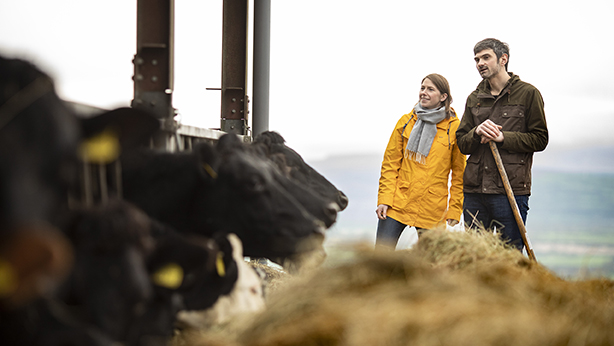Farmer Focus: Forage scheme dug us out of a hole
 Gillian and Neil O'Sullivan © Cathal Noonan
Gillian and Neil O'Sullivan © Cathal Noonan Grass growth only saw a significant increase in the second week of May.
Prior to this, persistent rain and temperatures around 9-10C left many silage fields seemingly stuck in winter mode.
Farmers aiming to hit “magic day” in early April – when grass growth meets and exceeds demand – found themselves stretching their grass supplies for much longer.
This led to tightening forage stocks in the south and east of the country. In response, farm organisations lobbied for support measures.
See also: Irish dairy herd set to be cut 10% under government plans
Consequently, the Department of Agriculture introduced a six-week scheme to assist in transporting silage, straw, maize, hay, or fodder beet over longer distances from 1 April to 15 May.
For example, the scheme provided £25.50 for a 4×4 silage bale, or £34 a tonne of fodder beet or pit silage, for transport distances over 75km from the applicant’s farm.
The goal was to help surplus forage move from the West, to the South and East.
Uptake was limited as pockets of forage remained available locally, albeit at higher prices.
Silage bales in the South East made £42.50, and many were still moved at this price.
As grass growth improved in early May, our farm was looking at an empty forage larder, which was particularly concerning were dry conditions to emerge during summer.
First cuts were expected to be lighter than usual.
An online trading platform showed numerous opportunities to purchase silage bales at £21-£25 in the west of Ireland.
With the transport scheme’s closing date approaching, we visited several farms to assess available forage and consider our options.
We find our cows (milked once a day) tend to be half a condition score better off than twice-a-day cows.
We focused on buying bulky forage for the dry cows, rather than high-quality silage we felt we could produce ourselves.
Under the scheme, this worked out cheaper than home-grown, dry-cow silage.
Consequently, we decided to buy the equivalent of one-third of our first cut, using the scheme to cover transport costs.
We have, therefore, prioritised prompt cutting in May to achieve high quality.
This has hopefully given us an insurance policy against the weather pendulum swinging from wet and cold, to dry.
As always, the merry-go-round of problem solving while farming continues.

